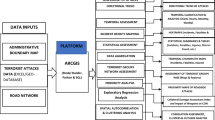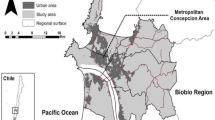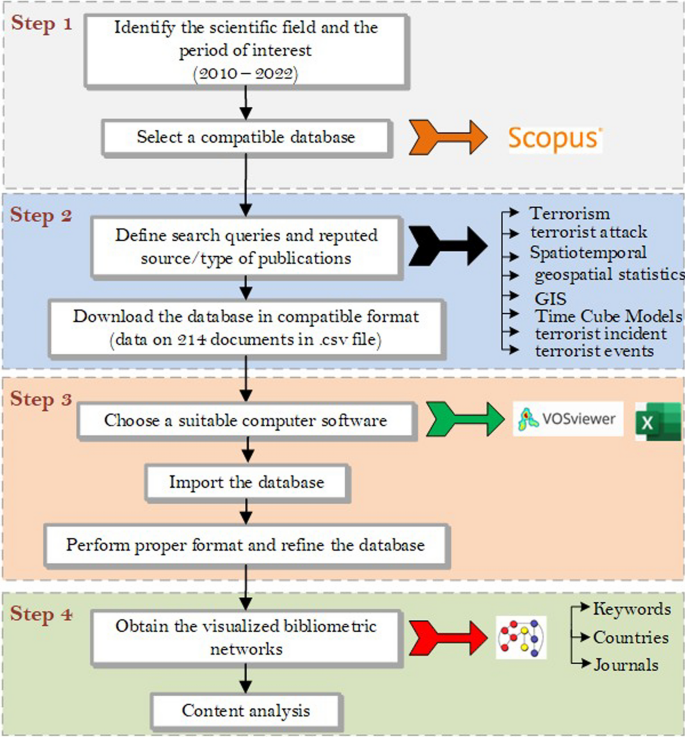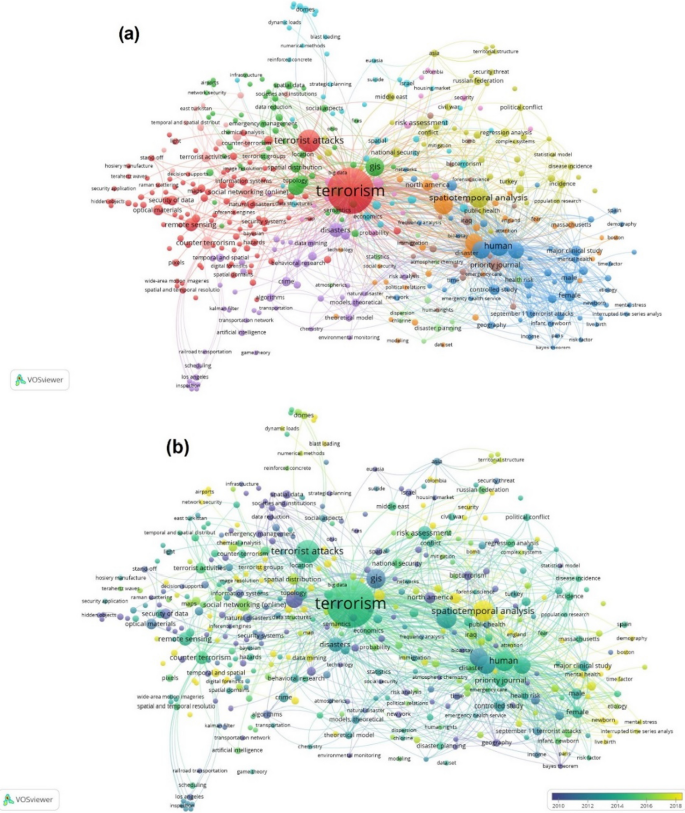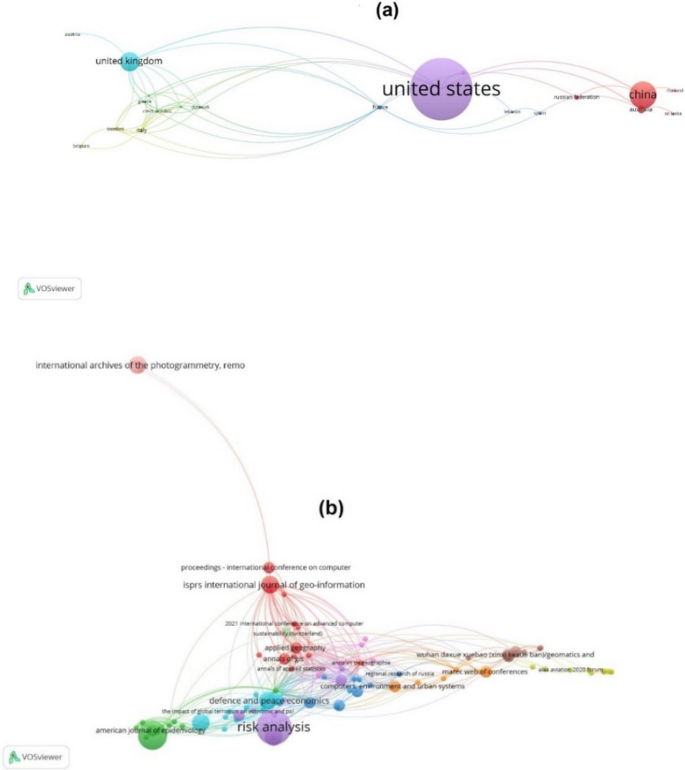Abstract
Terrorist attacks epitomize a direct threat to the security of Middle Eastern citizens as well as global stability. As one of the Middle Eastern countries, Egypt suffers from terrorism in terms of human life and economic loss. Studying the spatial distribution of terrorist attacks and factors that may affect their frequency is critical for understanding this violent behavior and hel** decision-makers fight terrorism. This study examines the spatial distribution of terrorist attacks in Egypt between 2004 and 2019 and its correlated factors. To fulfill this aim, spatial and spatiotemporal analyses were applied to analyze terrorist attack hotspots in the country, and 14 geographical, natural, social, and economic factors were tested for significant correlation to terrorist attacks by utilizing statistical and geographical weighted regression (GWR) analysis. Spatial distribution analysis results for the whole study period revealed two main hotspots: one in Greater Cairo, the capital of Egypt, and the second in the North Sinai Peninsula. There were additional small hotspots in Alexandria City, the Nile Delta region, and the northern part of the Nile Delta. The statistical analysis concluded a significant positive correlation between terrorist attacks and the fragile state index, education index, precipitation, distance to the land boundary, population density, poverty index, economic freedom index, and unemployment rate. Whereas, freedom index and distance to maritime boundaries had a significant negative correlation with terrorist attacks. GWR revealed significant positive correlations between terrorist attacks and NTL, population density, precipitation, and temperature in the North Sinai Governorate. The same governorate showed a negative correlation between terrorist attacks from one side and topography and drought index from the other.
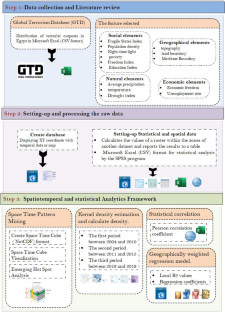







Similar content being viewed by others
References
Abadie, A. (2006). Poverty, political freedom, and the roots of terrorism. American Economic Review, 96(2), 50–56. https://doi.org/10.1257/000282806777211847
Abozaid, A. M. (2020). Counterterrorism strategy and human rights in Egypt after the Arab uprising: A critical appraisal. Aggression and Violent Behavior, 51, 101385. https://doi.org/10.1016/J.AVB.2020.101385
Adelaja, A., & George, J. (2020). Is youth unemployment related to domestic terrorism? Perspectives on Terrorism, 14(5), 41–62.
Alexandrani, I. (2016). Sinai: From Revolution to Terrorism. Egypt’s Revolutions, pp. 179–196. https://doi.org/10.1007/978-1-137-56322-4_10
Anneli Botha. (2006). Politics and terrorism : an assessment of the origin and threat of terrorism in Egypt | Institute for Security Studies Papers https://journals.co.za/doi/epdf/10.10520/EJC48790
Bandyopadhyay, S., & Younas, J. (2011). Poverty, political freedom, and the roots of terrorism in develo** countries: An empirical assessment. Economics Letters, 112(2), 171–175. https://doi.org/10.1016/J.ECONLET.2011.03.029
Barros, C. P., Faria, J. R., & Gil-Alana, L. A. (2008). Terrorism against American citizens in Africa: Related to poverty? Journal of Policy Modeling, 30(1), 55–69. https://doi.org/10.1016/J.JPOLMOD.2007.07.004
Bell, C., & Keys, P. W. (2018). Conditional relationships between drought and civil conflict in sub-saharan Africa. Foreign Policy Analysis, 14(1), 1–23. https://doi.org/10.1093/FPA/ORW002
Bertoni, E., Di Maio, M., Molini, V., & Nisticò, R. (2019). Education is forbidden: The effect of the Boko Haram conflict on education in North-East Nigeria. Journal of Development Economics, 141, 102249. https://doi.org/10.1016/J.JDEVECO.2018.06.007
Bhui, K., Warfa, N., & Jones, E. (2014). Is violent radicalisation associated with poverty, migration, poor self-reported health and common mental disorders? PLoS ONE, 9(3), e90718. https://doi.org/10.1371/JOURNAL.PONE.0090718
Braithwaite, A., Li, Q., Braithwaite, A., & Li, Q. (2007). Transnational terrorism hot spots: Identification and impact evaluation. Conflict Management and Peace Science, 24(4), 281–296. https://doi.org/10.1080/07388940701643623
Brockhoff, S., Krieger, T., & Meierrieks, D. (2015). Great expectations and hard times: The (Nontrivial) impact of education on domestic terrorism. Journal of Conflict Resolution, 59(7), 1186–1215. https://doi.org/10.1177/0022002713520589/ASSET/IMAGES/LARGE/10.1177_0022002713520589-FIG1.JPEG
Buffa, C., Sagan, V., Brunner, G., & Phillips, Z. (2022). Predicting terrorism in Europe with remote sensing, spatial statistics, and machine learning. ISPRS International Journal of Geo-Information, 11(4), 211. https://doi.org/10.3390/IJGI11040211
Buhaug, H., & Rød, J. K. (2006). Local determinants of African civil wars, 1970–2001. Political Geography, 25(3), 315–335. https://doi.org/10.1016/J.POLGEO.2006.02.005
Capmas. (2022). Central Agency for Public Mobilization and Statistics. https://www.capmas.gov.eg/HomePage.aspx
Caruso, R., & Gavrilova, E. (2012). Youth unemployment, terrorism and political violence, evidence from the Israeli/Palestinian conflict. Peace Economics, Peace Science and Public Policy,. https://doi.org/10.1515/1554-8597.1254/MACHINEREADABLECITATION/RIS
Choi, S. W., & Luo, S. (2013). Economic sanctions, poverty, and International terrorism: An empirical. Analysis, 39(2), 217–245. https://doi.org/10.1080/03050629.2013.768478
Coccia, M. (2020). Destructive technologies for industrial and corporate change. Global Encyclopedia of Public Administration, Public Policy, and Governance. Springer. Cham., 10, 978–983. https://doi.org/10.1007/978-3-319-31816-5_3969-1
Coscieme, L., Sutton, P. C., Anderson, S., Liu, Q., & Elvidge, C. D. (2017). Dark times: Nighttime satellite imagery as a detector of regional disparity and the geography of conflict. Giscience and Remote Sensing, 54(1), 118–139. https://doi.org/10.1080/15481603.2016.1260676
Danzell, O. E., Yeh, Y. Y., & Pfannenstiel, M. (2020). Does education mitigate terrorism? Examining the effects of educated youth cohorts on domestic terror in Africa. Terrorism and Political Violence, 32(8), 1731–1752. https://doi.org/10.1080/09546553.2018.1506336
Das, T., Jana, A., Mandal, B., & Sutradhar, A. (2022). S patio-temporal pattern of land use and land cover and its effects on land surface temperature using remote sensing and GIS techniques: A case study of Bhubaneswar city, Eastern India (1991–2021). GeoJournal, 87, 765–795. https://doi.org/10.1007/S10708-021-10541-Z
Delbiso, T. D., Rodriguez-Llanes, J. M., Donneau, A. F., Speybroeck, N., & Guha-Sapir, D. (2017). Drought, conflict and children’s undernutrition in Ethiopia 2000–2013: a meta-analysis. Bulletin of the World Health Organization, 95(2), 94. https://doi.org/10.2471/BLT.16.172700
Ding, F., Ge, Q., Jiang, D., Fu, J., & Hao, M. (2017). Understanding the dynamics of terrorism events with multiple-discipline datasets and machine learning approach. PLoS ONE, 12(6), e0179057. https://doi.org/10.1371/JOURNAL.PONE.0179057
Dunne, J. P., & Tian, N. (2017). Conflict and fragile states in Africa. . https://www.afdb.org/fileadmin/uploads/afdb/Documents/Publications/WPS_No_274__Conflict_and_Fragile_States_in_Africa__.pdf
Duru, H., Onat, I., Akyuz, K., & Akbas, H. (2021). Microcycles of terrorist violence in Turkey: A spatio-temporal analysis of the PKK attacks. Asian Journal of Criminology, 16(3), 235–256. https://doi.org/10.1007/S11417-020-09326-Z/TABLES/4
Elkadeem, M. R., Younes, A., Sharshir, S. W., Campana, P. E., & Wang, S. (2021). Sustainable siting and design optimization of hybrid renewable energy system: A geospatial multi-criteria analysis. Applied Energy, 295, 117071. https://doi.org/10.1016/j.apenergy.2021.117071
Elkadeem, M. R., Younes, A., Mazzeo, D., Jurasz, J., Campana, P. E., Sharshir, S. W., & Alaam, M. A. (2022). Geospatial-assisted multi-criterion analysis of solar and wind power geographical-technical-economic potential assessment. Applied Energy, 322, 119532. https://doi.org/10.1016/J.APENERGY.2022.119532
Esri. (2022a). Calculate density (geoanalytics desktop)—ArcGIS Pro | Documentation. Retrieved August 5, 2022, from https://pro.arcgis.com/en/pro-app/2.8/tool-reference/geoanalytics-desktop/calculate-density.htm.
Esri. (2022b). Geographically Weighted Regression (GWR) (Spatial Statistics)—ArcGIS Pro | Documentation. (n.d.). Retrieved August 5, 2022, from https://pro.arcgis.com/en/pro-app/2.8/tool-reference/spatial-statistics/geographicallyweightedregression.htm.
Esri. (2022c). How create space time cube works—ArcGIS Pro | Documentation. https://pro.arcgis.com/en/pro-app/2.8/tool-reference/space-time-pattern-mining/learnmorecreatecube.htm (Accessed 01 Aug 2022).
Freytag, A., Krüger, J. J., Meierrieks, D., & Schneider, F. (2011). The origins of terrorism: Cross-country estimates of socio-economic determinants of terrorism. European Journal of Political Economy, 27(SUPPL. 1), S5–S16. https://doi.org/10.1016/J.EJPOLECO.2011.06.009
FSI. (2023). Fragile states index | the fund for peace. https://fragilestatesindex.org/
Garnett, J. (2015). Terrorism and the Rise of ISIS in Egypt. MSU Graduate Theses. https://bearworks.missouristate.edu/theses/2551
Gleick, P. H. (2014). Water, drought, climate change, and conflict in Syria. Weather, Climate, and Society, 6(3), 331–340. https://doi.org/10.1175/WCAS-D-13-00059
Goldstein, K. (2005). Unemployment, inequality and terrorism: Another look at the relationship between economics and terrorism. Undergraduate Economic Review, 1(1). https://digitalcommons.iwu.edu/uer/vol1/iss1/6
GTD. (2022). GTD. Global terrorism database. 2022. https://www.start.umd.edu/gtd/
Hao, M., Jiang, D., Ding, F., Fu, J., & Chen, S. (2019). Simulating Spatio-Temporal Patterns of Terrorism Incidents on the Indochina Peninsula with GIS and the Random Forest Method. ISPRS International Journal of Geo-Information, 8(3), 133. https://doi.org/10.3390/IJGI8030133
HDR. (2023). Human Development Reports. https://hdr.undp.org/indicators/103606
Hendrix, C. S., & Glaser, S. M. (2007). Trends and triggers: Climate, climate change and civil conflict in Sub-Saharan Africa. Political Geography, 26(6), 695–715. https://doi.org/10.1016/J.POLGEO.2007.06.006
HFI. (2023). Human Freedom Index: 2022 | Cato Institute. https://www.cato.org/human-freedom-index/2022
Hoffman, A. M., Shelton, C., & Cleven, E. (2013). Press freedom, publicity, and the cross-national incidence of transnational. Terrorism, 66(4), 896–909.
Holden, A., Sonne, J., & Novelli, M. (2011). Tourism and Poverty Reduction: An interpretation by the Poor of Elmina. Ghana., 8(3), 317–334. https://doi.org/10.1080/21568316.2011.591160
Ide, T. (2020). Teaching terrorism, saving the state? Education and geopolitical imaginations of terrorism in 12 violently challenged states. Political Geography, 77, 102125. https://doi.org/10.1016/J.POLGEO.2019.102125
Imran, S., Amin, M., Tahir, M. N., Imran, M., Karim, S., & Usman, T. (2023). Geographical spread analysis of terrorist attacks in Pakistan. GeoJournal. https://doi.org/10.1007/S10708-023-10885-8/METRICS
Jato-Espino, D., & Mayor-Vitoria, F. (2023). A statistical and machine learning methodology to model rural depopulation risk and explore its attenuation through agricultural land use management. Applied Geography, 152, 102870. https://doi.org/10.1016/J.APGEOG.2023.102870
Karmaoui, A., el Jaafari, S., Chaachouay, H., & Hajji, L. (2022). The socio-ecological system of the pre-Sahara zone of Morocco: A conceptual framework to analyse the impact of drought and desertification. GeoJournal, 87(6), 4961–4974. https://doi.org/10.1007/S10708-021-10546-8/METRICS
Kondo, K. (2016). Hot and cold spot analysis using stata. The Stata Journal, 16(3), 613–631. https://doi.org/10.1177/1536867X1601600304
Korotayev, A., Vaskin, I., & Tsirel, S. (2021). Economic growth, education, and terrorism: A Re-analysis. Terrorism and Political Violence, 33(3), 572–595. https://doi.org/10.1080/09546553.2018.1559835
Krieger, T., Brockhoff, S., & Meierrieks, D. (2012a). Great expectations and hard times the (Nontrivial) impact of education on domestic terrorism. https://www.econstor.eu/handle/10419/62083
Krueger, A. B., & Malečková, J. (2003). Education, poverty and terrorism: Is there a causal connection? Journal of Economic Perspectives, 17(4), 119–144. https://doi.org/10.1257/089533003772034925
Kurrild-Klitgaard, P., Justesen, M. K., & Klemmensen, R. (2006). The political economy of freedom, democracy and transnational terrorism. Public Choice, 128(1–2), 289–315. https://doi.org/10.1007/S11127-006-9055-7/METRICS
LaFree, G., Dugan, L., **e, M., & Singh, P. (2012). Spatial and temporal patterns of terrorist attacks by ETA 1970 to 2007. Journal of Quantitative Criminology, 28(1), 7–29. https://doi.org/10.1007/S10940-011-9133-Y
Li, Q. (2005). Does democracy promote or reduce transnational terrorist incidents? Journal of Conflict Resolution, 49(2), 278–297. https://doi.org/10.1177/0022002704272830/SUPPL_FILE/LI_DATA.ZIP
Li, X., Liu, S., Jendryke, M., Li, D., & Wu, C. (2018). Night-time light dynamics during the Iraqi civil war. Remote Sensing, 10(6), 858. https://doi.org/10.3390/RS10060858
Li, Z., Li, X., Dong, C., Guo, F., Zhang, F., & Zhang, Q. (2021). Quantitative analysis of global terrorist attacks based on the global terrorism database. Sustainability, 13(14), 7598. https://doi.org/10.3390/SU13147598
Lynch, M. J., Stretesky, P. B., Long, M. A., & Barrett, K. L. (2022). The climate change-temperature-crime hypothesis: evidence from a sample of 15 large US cities, 2002 to 2015. International Journal of Offender Therapy and Comparative Criminology, 66(4), 430–450. https://doi.org/10.1177/0306624X20969934
Mach, K. J., Kraan, C. M., Adger, W. N., Buhaug, H., Burke, M., Fearon, J. D., & von Uexkull, N. (2019). Climate as a risk factor for armed conflict. Nature, 571(7764), 193–197. https://doi.org/10.1038/s41586-019-1300-6
Mandel, D. R. (2005). Are risk assessments of a terrorist attack coherent? Journal of Experimental Psychology: Applied, 11(4), 277–288. https://doi.org/10.1037/1076-898X.11.4.277
Mann, H. B. (1945). Nonparametric tests against trend. Econometrica, 13(3), 245. https://doi.org/10.2307/1907187
Mansour, S., Al Kindi, A., Al-Said, A., Al-Said, A., & Atkinson, P. (2021). Sociodemographic determinants of COVID-19 incidence rates in Oman: Geospatial modelling using multiscale geographically weighted regression (MGWR). Sustainable Cities and Society, 65, 102627. https://doi.org/10.1016/J.SCS.2020.102627
Medina, R. M., Siebeneck, L. K., & Hepner, G. F. (2011). A geographic information systems (GIS) analysis of spatiotemporal patterns of terrorist incidents in Iraq 2004–2009. Studies in Conflict and Terrorism, 34(11), 862–882. https://doi.org/10.1080/1057610X.2011.611933
Mohamadi, B., Balz, T., & Younes, A. (2020). Towards a PS-InSAR based prediction model for building collapse: Spatiotemporal patterns of vertical surface motion in collapsed building areas—case study of alexandria. Egypt. Remote Sensing, 12(20), 3307. https://doi.org/10.3390/RS12203307
Monem, A., & Aly, S. (2014). Deciphering Abdel Fattah el-Sisi: President of Egypt’s Third Republic. Crown Center for Middle East Studies, 82.
NASA. (2023). Socioeconomic data and applications center. https://sedac.ciesin.columbia.edu/data/set/ndhmultihazard-frequency-distribution
NOAA. (2023). NOAA/NGD earth observation group. https://www.ngdc.noaa.gov/eog/
Novelli, M. (2017). Education and countering violent extremism: Western logics from south to north? Compare, 47(6), 835–851. https://doi.org/10.1080/03057925.2017.1341301
Ord, J. K., & Getis, A. (1995). Local spatial autocorrelation statistics: Distributional issues and an application. Geographical Analysis, 27(4), 286–306. https://doi.org/10.1111/J.1538-4632.1995.TB00912.X
Østby, G., Urdal, H., & Dupuy, K. (2019). Does education lead to pacification? A systematic review of statistical studies on education and political violence. Review of Educational Research, 89(1), 46–92. https://doi.org/10.3102/0034654318800236/ASSET/IMAGES/LARGE/10.3102_0034654318800236-FIG1.JPEG
Parker, R. I., Vannest, K. J., Davis, J. L., & Sauber, S. B. (2011). Combining nonoverlap and trend for single-case research: Tau-U. Behavior Therapy, 42(2), 284–299. https://doi.org/10.1016/J.BETH.2010.08.006
Piazza, J. A. (2006). Rooted in Poverty?: Terrorism, poor economic development, and social cleavages. Terrorism and Political Violence, 18(1), 159–177. https://doi.org/10.1080/095465590944578
Piazza, J. A. (2011). Poverty, minority economic discrimination, and domestic terrorism. Journal of Peace Research, 48(3), 339–353. https://doi.org/10.1177/0022343310397404
Polat, Z. A. (2019). Evolution and future trends in global research on cadastre: a bibliometric analysis. GeoJournal, 84(4), 1121–1134. https://doi.org/10.1007/s10708-019-09973-5
Polyzos, E., Papadopoulou, G., & Xesfingi, S. (2021). Examining the link between terrorism and tourism demand: The case of Egypt. https://papers.ssrn.com/abstract=3830988
Purwanto, P., Utaya, S., Handoyo, B., Bachri, S., Astuti, I. S., Sastro, K., Utomo, B., & Aldianto, Y. E. (2021). Spatiotemporal analysis of COVID-19 spread with emerging hotspot analysis and space-time cube models in east java. Indonesia. IJGI, 10(3), 133. https://doi.org/10.3390/IJGI10030133
Raleigh, C., & Urdal, H. (2007). Climate change, environmental degradation and armed conflict. Political Geography, 26(6), 674–694. https://doi.org/10.1016/J.POLGEO.2007.06.005
Regan, P. M., & Kim, H. (2020). Water scarcity, climate adaptation, and armed conflict: insights from Africa. Regional Environmental Change, 20, 1–14. https://doi.org/10.1007/S10113-020-01713-7
Sandler, T., & George, J. (2016). Military expenditure trends for 1960–2014 and what they reveal. Global Policy, 7(2), 174–184. https://doi.org/10.1111/1758-5899.12328
Salameh, M. T. B., & Hourani, I. (2022). The Impact of Terrorism on Tourism: Pilot Study 2007–2017 Case Study of Jordan, Egypt, Spain and France. Dirasat: Human and Social Sciences, 49(1), 639-658. https://doi.org/10.35516/HUM.V49I1.1691
Savun, B., & Phillips, B. J. (2009). Democracy, foreign policy, and terrorism. Journal of Conflict Resolution, 53(6), 878–904. https://doi.org/10.1177/0022002709342978
Scheffran, J., Brzoska, M., Kominek, J., Link, P. M., & Schilling, J. (2012). Climate change and violent conflict. Science, 336(6083), 869–871. https://doi.org/10.1126/SCIENCE.1221339/SUPPL_FILE/1221339-SCHEFFRAN.SM.PDF
Schumacher, M. J., & Schraeder, P. J. (2021). Does domestic political instability foster terrorism? Global evidence from the Arab spring Era (2011–14). Studies in Conflict and Terrorism, 44(3), 198–222.
Servold GM. (2003). The muslim brotherhood and islamic radicalism. Indianstrategicknowledgeonline.Com. https://indianstrategicknowledgeonline.com/web/The%20Muslim%20Brotherhood%20and%20Islamic%20Radicalism.pdf
Shay, S. (2016). Egypt’s war against the tunnels between Sinai and Gaza Strip. https://www.runi.ac.il/media/ij3hrs1v/egypttunnelsshaulshay01-16.pdf
Sheather, S. J., & Jones, M. C. (1991). A reliable data-based bandwidth selection method for kernel density estimation. Journal of the Royal Statistical Society: Series B (methodological), 53(3), 683–690. https://doi.org/10.1111/J.2517-6161.1991.TB01857.X
Siebeneck, L. K., Medina, R. M., Yamada, I., & Hepner, G. F. (2009). Spatial and temporal analyses of terrorist incidents in Iraq, 2004–2006. Studies in Conflict and Terrorism, 32(7), 591–610. https://doi.org/10.1080/10576100902961789
Singh, P. P., & Philip, D. (2023). Modelling and analysis of high impact terrorist attacks in India and its neighbors. ISPRS International Journal of Geo-Information, 12(4), 162. https://doi.org/10.3390/IJGI12040162
Temizhan, E., Mirtagioglu, H., & Mendes, M. (2022). Which correlation coefficient should be used for investigating relations between quantitative variables. Acad. Sci. Res. J. Eng. Technol. Sci, 85, 265–277.
The Global Economy. (2023). Egypt Economic freedom, overall index - data, chart | TheGlobalEconomy.com. https://www.theglobaleconomy.com/Egypt/economic_freedom/
The World Bank. (2023). World Bank group-International development, poverty, & sustainability. https://www.worldbank.org/en/home
Theisen, O. M., Holtermann, H., & Buhaug, H. (2012). Climate Wars? Assessing the claim that drought breeds conflict. International Security, 36(3), 79–106. https://doi.org/10.1162/ISEC_A_00065
Von Uexkull, N. (2014). Sustained drought, vulnerability and civil conflict in Sub-Saharan Africa. Political Geography, 43, 16–26. https://doi.org/10.1016/J.POLGEO.2014.10.003
Wang, J., Wang, S., & Li, S. (2019a). Examining the spatially varying effects of factors on PM2.5 concentrations in Chinese cities using geographically weighted regression modeling. Environmental Pollution, 248, 792–803. https://doi.org/10.1016/J.ENVPOL.2019.02.081
Wang, Y., Li, X., Kang, Y., Chen, W., Zhao, M., & Li, W. (2019b). Analyzing the impact of urbanization quality on CO2 emissions: What can geographically weighted regression tell us? Renewable and Sustainable Energy Reviews, 104, 127–136. https://doi.org/10.1016/J.RSER.2019.01.028
Wasike, C. N. (2019). Assessing the future of managing economic and financial terrorism risks in Kenya. pp. 97–111. https://doi.org/10.1007/978-3-030-01740-8_7
Weinberg, L. B., Eubank, W. L., & Francis, E. A. (2008). The cost of terrorism: The relationship between international terrorism and democratic governance. Terrorism and Political Violence, 20(2), 257–270. https://doi.org/10.1080/09546550801907615
WorldClim. (2023). WorldClim. https://www.worldclim.org/
Wu, D. (2020). Spatially and temporally varying relationships between ecological footprint and influencing factors in China’s provinces using geographically weighted regression (GWR). Journal of Cleaner Production, 261, 121089. https://doi.org/10.1016/J.JCLEPRO.2020.121089
**e, Z., & Yan, J. (2008). Kernel density estimation of traffic accidents in a network space. Computers, Environment and Urban Systems, 32(5), 396–406. https://doi.org/10.1016/J.COMPENVURBSYS.2008.05.001
Younes, A., Kotb, K. M., Abu Ghazala, M. O., & Elkadeem, M. R. (2022). Spatial suitability analysis for site selection of refugee camps using hybrid GIS and fuzzy AHP approach: The case of Kenya. International Journal of Disaster Risk Reduction, 77, 103062. https://doi.org/10.1016/J.IJDRR.2022.103062
Zhang, X., **, M., Fu, J., Hao, M., Yu, C., & **e, X. (2018). On the risk assessment of terrorist attacks coupled with multi-source factors. ISPRS International Journal of Geo-Information, 7(9), 354. https://doi.org/10.3390/IJGI7090354
Zhao, R., **e, X., Zhang, X., **, M., & Hao, M. (2021). Spatial distribution assessment of terrorist attack types based on I-MLKNN model. ISPRS International Journal of Geo-Information, 10(8), 547. https://doi.org/10.3390/IJGI10080547
Author information
Authors and Affiliations
Corresponding author
Ethics declarations
Conflict of interest
The authors declare that they have no conflicts of interest.
Human and animal rights statement
This article does not contain any studies involving animals or human participants performed by any of the authors.
Additional information
Publisher's Note
Springer Nature remains neutral with regard to jurisdictional claims in published maps and institutional affiliations.
Appendix
Appendix
See Figs.
The plan for how the bibliometric analysis was done, based on how the VOSviewer software was used to do the analysis (Karmaoui et al., 2022). The plan is based on the Scopus database from 2010 to 2022. The bibliometric data source was extracted from the online version of the Scopus database. The search query was chosen to serve the primary goal of this study as “TITLE-ABS-KEY (“terrorist attack” OR “Terrorism" OR “terrorist systems “ OR “terrorist incident” OR “terrorist group” OR “Global Terrorism” OR “terrorist events “AND “spatial” OR “spatiotemporal” OR “geospatial statistics” OR “GIS” OR “Time Cube Models” OR “Optimized Hot Spot Analysis” OR “Geographically Weighted Regression” OR “GWR” OR “Ordinary Least Squares (OLS)” OR “spatial autocorrelation”)
9,
Keywords co-occurrence network the context of the studied subject a Network visualization by cluster b Overlay visualization by average publication date (Note: circle = keyword; circle diameter = frequency of a keyword appearance in the articles; color in (a) = cluster group; color in (b) = average publication year of the article that used the keywords). The (co-occurrence) keyword analysis selected 458 keywords (big and small circles) grouped in 6 clusters in different colors, as presented in Fig. 10a. Keywords that are recused regularly, which articles are intensely focused on, with outstanding inter-connection strength with other keywords are: Terrorism (163), terrorist attack (39) Spatiotemporal Analysis (31), Spatial Analysis (29), Human (28), GIS (26), In addition, the co-occurrence timeline visualization map over the last years (see Fig. 10b) enunciates the most recent emerging topics with a yellow color, including spatiotemporal analysis, spatial analysis, spatial distribution, and demographics, with an average publication year of 2018. Most important is that the analysis highlights that the number of studies on terrorism and terrorist attacks (red in Fig. 10a) is large and can be considered a relatively new or hot research topic for the vibrant research community
10 and
a Network visualization map of collaborative networks among countries in the investigated field of research. Each node represents a given country, and its size is relative to the number of published papers. b A network visualization map of the most cited journals concerning the research subject. Each node represents a journal name, and its size is relative to the number of articles in each country. The database shows that a total of 37 countries contributed to the literature. The country with the highest number of publications and collaborations with other states is the United States of America, with 85 documents, followed by China (37), the United Kingdom (26), Australia (10), the Russian Federation (7), and India (7). We note that authors in the United States of America have significant links with China and the United Kingdom, as well as European countries such as Sweden, Italy, Denmark, and Greece that have links to the United Kingdom and China. Figure 11b depicts a bibliographic network analysis of 25 prominent journals interested in the investigated subject regarding the source of publications. The analysis demonstrated that the proceedings of spie, the International Society for Optical Engineering and Risk Analysis, are highly productive journals with 25 research papers, lecture notes in computer science (5), the ISPRS international journal of geo-information (3), defense and peace economics (3), social science and medicine (3), applied geography (2), Wuhan daxue xuebao (xinxi kexue ban)/geomatics and information science of Wuhan University (2), It is expected that this information can assist researchers in choosing the most relevant, valid, and reliable journal to publish their findings
Rights and permissions
Springer Nature or its licensor (e.g. a society or other partner) holds exclusive rights to this article under a publishing agreement with the author(s) or other rightsholder(s); author self-archiving of the accepted manuscript version of this article is solely governed by the terms of such publishing agreement and applicable law.
About this article
Cite this article
Younes, A., Mohamadi, B. & AbuGhazala, M.O. Terrorism in Egypt: a comprehensive spatial, spatio-temporal, and statistical analysis. GeoJournal 88, 6339–6364 (2023). https://doi.org/10.1007/s10708-023-10972-w
Accepted:
Published:
Issue Date:
DOI: https://doi.org/10.1007/s10708-023-10972-w



